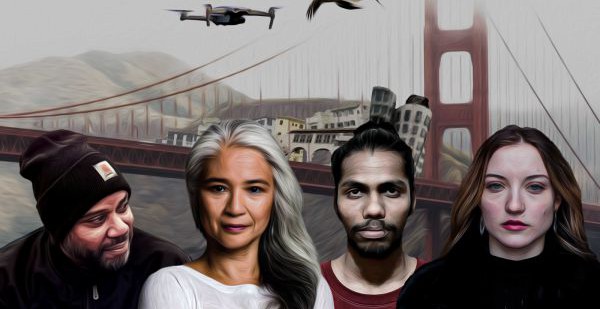
Fugen - frontend
Music Theater
SCHIMANA: FUGEN
Program
-
Elisabeth Schimana: Fugen – fragmentarisch vernetzt in 13 Bildern. Musiktheater auf Basis der Trilogie »Idoru« (Bridge) von William Gibson (Deutsche Übersetzung: Peter Robert)
(2021)
Libretto: Roland Quitt
Cast
- Thomas Gorbach: Akusmonium, Produktionsmanagement
- Sprecher*innen der Schauspielakademie Elfriede Ott:
Ensemble Laura Enzenhofer, Flora Punzer, Alina Weillechner, Lukas Aschenreiter, Clemens Gersthofer, Patrick Leitgöb, Katharina Schmirl, Leon Lembert
Aufgenommen im Hörspiel-Studio des ORF Funkhauses in Wien mit Studierenden der Schauspielakademie Ott - Chetan Yeragera: Performance
- Christina Maria Sutter: Performance
- Aiko Kazuko Kurosaki: Performance, Stimme
- Pete Simpson: Performance, Stimme
- Adele Knall: Elektronik, Stimme
- Gregor Ladenhauf: Max-Brand-Synthesizer, Stimme
- Manon-Liu Winter: Max-Brand-Synthesizer, Clavichord
- Philip Leitner: Bildregie Netzwerk-Programmierung
- Klaus Filip: Bildregie
- Susi Wisiak: Choreographieassistenz
- Jan Wagner: Licht
- Sigrid Reisenberger: Textregie
- Peter Venus: Technische Leitung
- Sigrid Reisenberger: Künstlerische Leitung Performance
- Roland Quitt: Dramaturgie
- Nora Scheidl: Raum, Konzept, Kostüm
In William Gibson's legendary cyberpunk novel trilogy Idoru (Bridge, consisting of the volumes Virtual Light, 1994; Idoru, 1996; All Tomorrow's Parties, 1999), we see collisions of powerful media moguls with hackers and bridge dwellers, collisions of physically present things and bodies with code-generated figures, or the collision of the continuous time of a clock's second hand with the timeless black hole of digital space. A kaleidoscope of viruses, drugs, weapons, data havens, slick PR managers, television believers, data krakens, avatars and much more. But the question of autonomy and the spaces in between, the cracks, remains an essential one.
So let's enter the spaces of possibility, the interstitial, as William Gibson calls them, polyphonies of voices where each voice is given a space, and complex, unpredictable structures emerge and decay in fragmentary networks. The physical bodies of the visitors, performers and musicians interweave with the eyes of a tablet installation and thus become observers and observed, while the voices of eight absent bodies narrate the 13 images generated by Roland Quitt from the Gibson text.
DIY electronics or the Max Brand synthesizer built in collaboration with Bob Moog symbolise resistance and self-empowerment. Keyboards hint at their centuries-old history as point of contact for machines. Powerful sounds of physical membrane models collide with field recordings and voices of present and absent bodies. The Vienna Acousmonium, a loudspeaker orchestra distributed throughout the room, hurls the sound shapes through the air and acoustically links the optical space, which is fragmented by heavy columns. In counterpoint, the individual voices drift through time and merge into a mesh of bodies, objects, light and ephemeral sound figures. (Elisabeth Schimana)
More events
Produktion netzzeit
Koproduktion Wien Modern und Kooperation ORF Ö1 Kunstradio mit freundlicher Unterstützung von Stadt Wien Kultur, BMKÖS, SKE und Wien Bibliothek im
Rathaus
Produktion netzzeit
Koproduktion Wien Modern und Kooperation ORF Ö1 Kunstradio mit freundlicher Unterstützung von Stadt Wien Kultur, BMKÖS, SKE und Wien Bibliothek im
Rathaus












